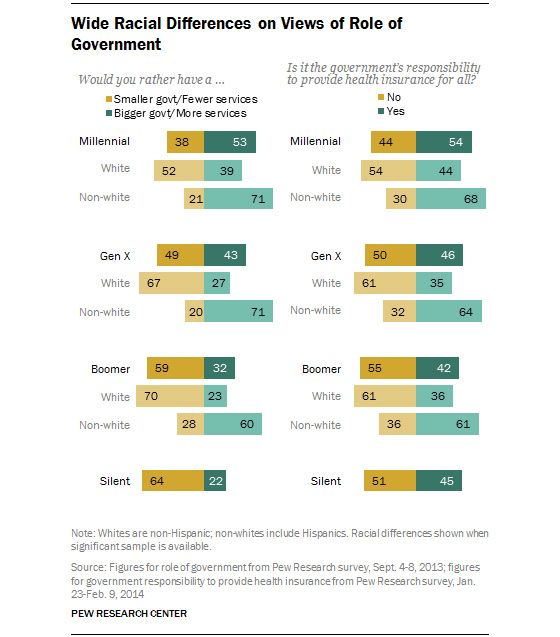
Barack Obama’s first term provoked the Republican Party’s most libertarian moment since the Goldwater campaign, or perhaps even the advent of the New Deal. Several things thrust the GOP in this direction. Needing to distance themselves from the failures of the now-departed Republican administration, most lurched toward the conclusion that George W. Bush had failed because he had embraced big government and forsaken the true free-market path. As it had under Bill Clinton, the Republican base grew more suspicious of the use of military power with a Democrat in office. And the scope of Obama’s economic agenda tended to overshadow social fissures. The result was an anti-statist outburst, bringing to the Party’s fore such libertarian figures as Glenn Beck, Rick Santelli, Paul Ryan, Rand Paul, and the Koch brothers; a huge spike in sales of Ayn Rand novels; and a flowering of bluntly anti-statist policy and rhetoric.
The force of this moment has already receded, as most Republicans have subsequently recognized that their dalliance with Randian themes saddled them with a massive political liability that they are working diligently to undo. The political energy lies in downplaying its anti-government extremism and repositioning the Party — either substantively or rhetorically, depending on your view — as a more middle-class-friendly entity.
Robert Draper’s New York Times Magazine cover story oddly presents libertarianism as the GOP’s possible future path and obvious salvation rather than a liability it is trying badly to shake off.
The premise undergirding the story is that libertarians hold a unique generational claim to America’s political future. Draper quotes the Reason Foundation’s pollster, who tells him that voters under 30 “agree with Democrats on social issues, and on economic issues lean more to the right.” The premise that young voters lean distinctly libertarian returns through the story repeatedly.

Reason has invested a great deal of money and time in promoting its claim to represent America’s youth, including regular polls that purport to bolster this claim. It’s important to understand that, since small changes in the framing of a poll can produce dramatically different responses, it is possible to produce polling that seems to show agreement with any position the sponsor of the poll desires. Advocacy organizations routinely sponsor polls that show the public supportive of their own position. Reason is the only magazine I know of that uses this tactic.
But polling produced by non-advocacy organizations does not yield this conclusion. It certainly shows that voters under 30, who vote strongly Democratic, have strongly liberal views on most foreign-policy and social issues, as libertarians do. The crucial difference lies in economics, where libertarians veer sharply right and young voters veer sharply left. This can be seen in specific instances, like health care, where young voters are far more likely than older ones to support an expanded government role. Like most Americans, they strongly support the maintenance of specific programs, such as Social Security. Unlike most Americans, they actually favor bigger government in the abstract:

Opposition to big government in the abstract is a hardy feature of American opinion. Older Americans oppose “bigger government” in the abstract by a margin of some 40 percentage points. That young voters actually favor “bigger government” in the abstract is a sea change in generational opinion, not to mention conclusive evidence against their alleged libertarianism.
Draper notes that “fully half of voters between ages 18 and 29 are unwedded to either party.” This is Reason’s most persistently repeated polling factoid. It is true that younger voters are more likely than older voters to self-identify as independents. This represents a longstanding generational shift — identification as an independent signals an openness to evidence rather than reflexive party loyalty. But political scientists and pollsters alike recognize that identification as an “independent” does not mean a propensity to change one’s partisan voting behavior. Functional partisans are simply more likely to call themselves “independents,” which explains why millenials’ strong tendency to self-identify as independent coexists with their strong tendency to vote Democratic. (It also explains why the libertarian show on the Fox Business Network is called The Independents.)
It is true that some social issues have also weighed on the Party. Draper presents Rand Paul as the primary driving force in the Party’s efforts to minimize its social liabilities, though there’s no evidence that Paul has gone farther than other mainstream Republicans on this front. He opposes gay marriage and immigration reform, though, like many other Republicans, seeks to downplay them as issues. He has advocated more lenient sentencing laws, but so have numerous other Republicans, like Rick Perry and Paul Ryan. Draper calls Paul “the only likely Republican presidential candidate to venture into the hostile territory of college campuses and Latino and African-American groups.” That is clearly not true.

Draper’s story presents the libertarians’ self-conception in their preferred terms. It describes the Competitive Enterprise Institute, which funds an annual libertarian gala in Washington, as “a 30-year-old organization that routinely sues federal agencies, often when new and onerous regulations are posted in the Federal Register,” as opposed to, say, a think tank advocating the regulatory interests of its business donors, primarily the denial of climate science.
Draper describes Nick Gillespie, the “intellectual godfather” of the libertarian magazine Reason, who is known for appearing in Washington in all weather, outdoors and indoors, clad in his trademark leather jacket, like so:
Nick Gillespie is to libertarianism what Lou Reed is to rock ‘n’ roll, the quintessence of its outlaw spirit. He is 50, a former writer for teen and heavy-metal magazines, habitually garbed in black from head to toe, wry and mournful in expression, a tormented romantic who quotes Jack Kerouac.






























